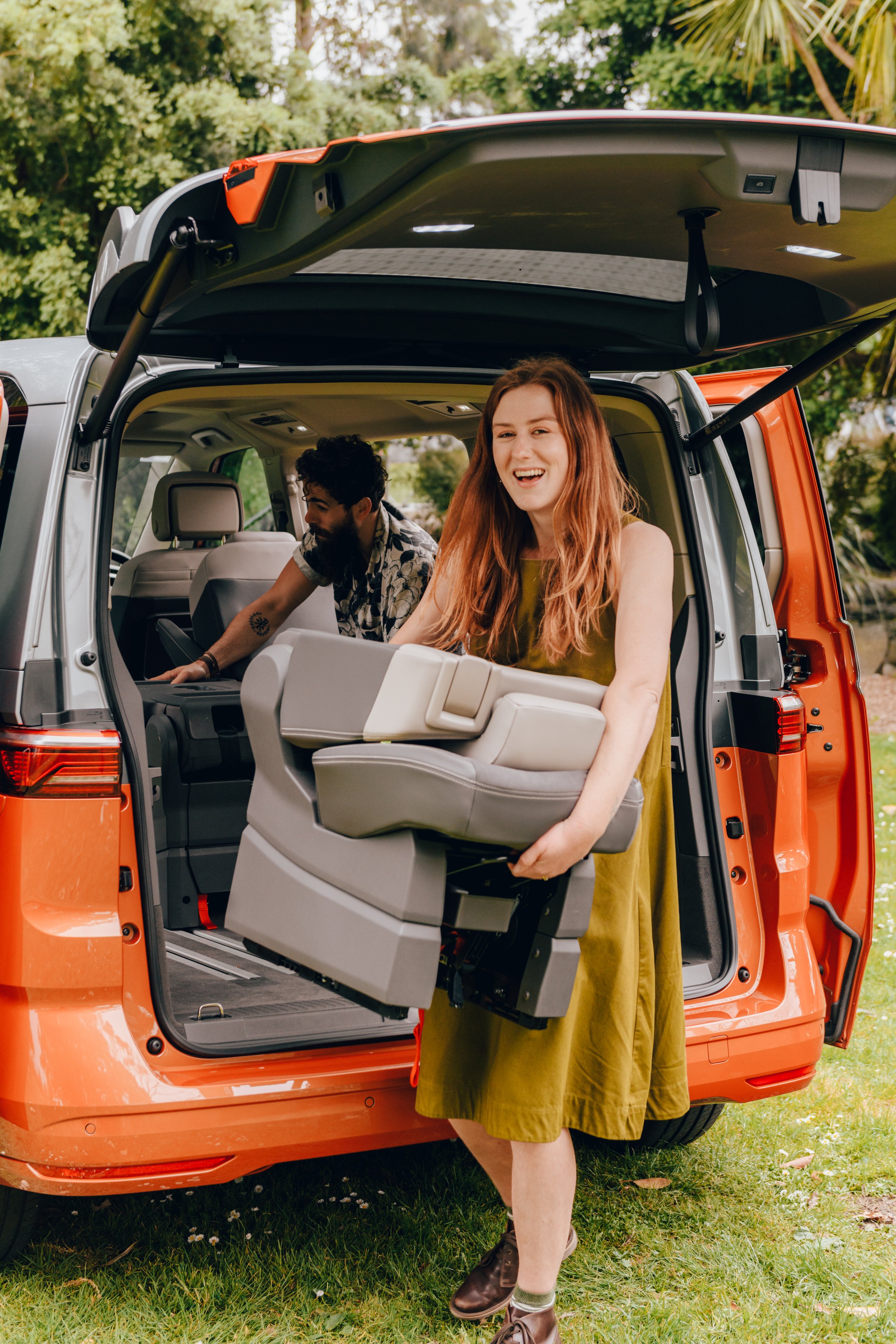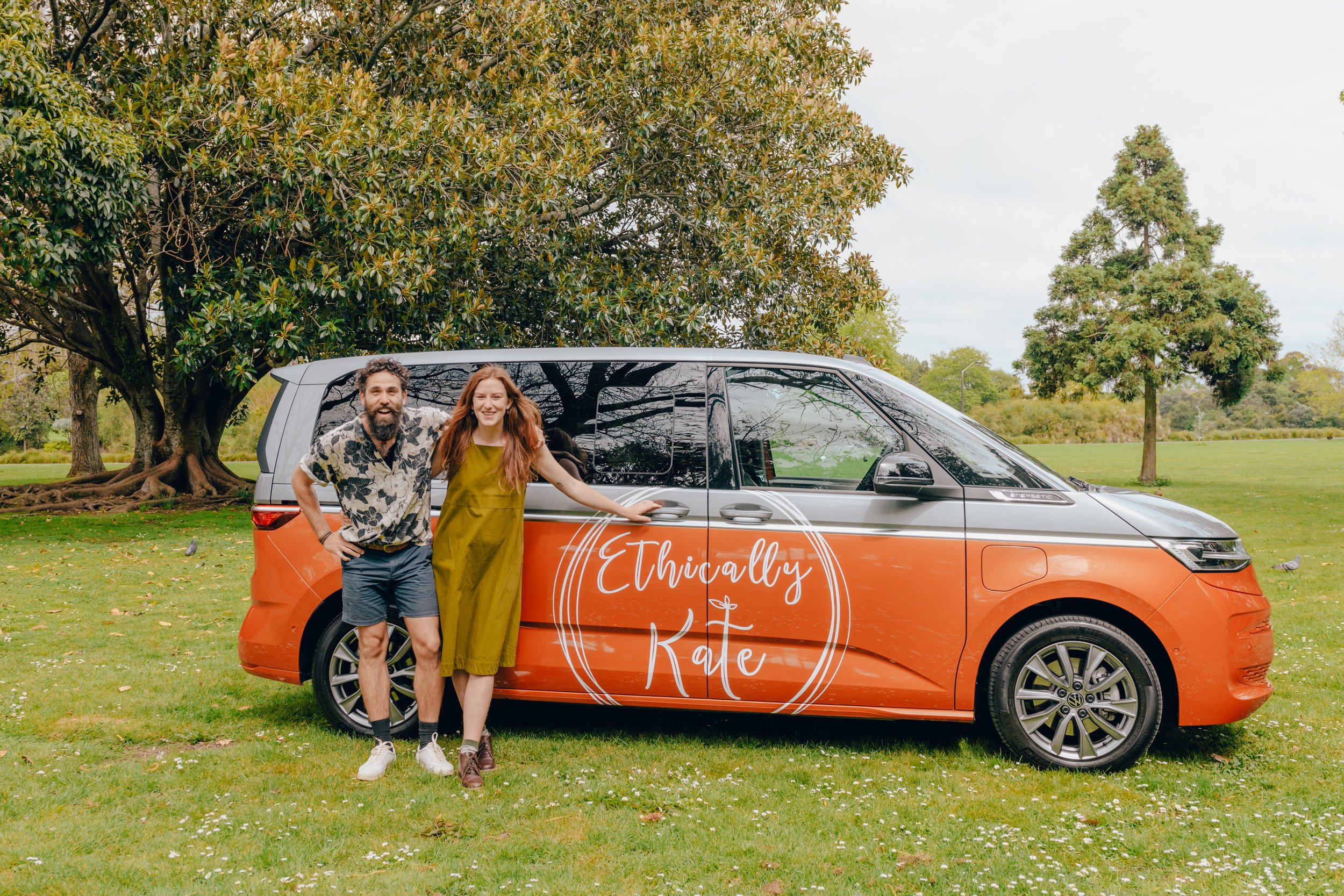Travelling New Zealand in a Volkswagen Multivan
Earlier this year, a friend sent me a link to a TEDx talk about electric vehicles. At first glance, I thought the person presenting was wearing a shirt that said “THE FUTURE IS ELECTRIC”. As a sustainability advocate, I agreed with the sentiment but quickly realised the shirt truly said “THE FUTURE IS ECLECTIC”. The TEDx talk was relatively controversial and although I don’t agree with everything the presenter said, their points around the validity of hybrid vehicles continued to bounce around in my head.
Fast forward a few months… I was planning my nationwide book tour and contemplating how to sustainably transport myself, my husband, boxes of books, and event props around the country for three weeks. Hitchhiking was a no-go, busing was impossible, and I had never seen an electric vehicle big enough for the volume of things I needed to bring with me.
Having partnered with Volkswagen for the last two years, I asked if they had a solution.
Enter: Fran the Multivan.
The Multivan is brand new to the Volkswagen fleet and it’s an absolute honour to hoon around the country in it for the month of November. Even though it’s a plug-in Hybrid, the Multivan still pays homage to the DNA of its Kombi predecessor with its classic shape and style. It’s perfect for my book tour requirements, but surprisingly the Multivan wasn’t designed for book tours only. This vehicle is an epic solution for Kiwi families to transport their tamariki to school on pure electric mode or get to work using electricity supported by a small amount of fuel.
The Plug-In Hybrid Multivan
When I picked up Fran the PHEV Multivan, I embarrassed myself by jumping around the car in an over-excited way, just like the kid I saw yesterday who ran along the footpath screaming “BURGERS!!!!” as she made her way into the burger shop. Yes, my logo looks freaking epic on the side (pinch me), but the van features are the true glee-inducing moments for me.
Firstly, Fran wakes up when I get close. She senses my presence (nothing to do with the fact the car keys are in my pocket or handbag) and unlocks; poking out her ears (side mirrors) and preparing herself for our next adventure. Fran has so much leg room and space that when you sit down in the driver’s seat your brain and body say ‘okay, let’s roadtrip’. She can seat 7 people, but because it’s just the two of us on tour, we removed three of the seats - and it was easy peasy! The seats slide up and down rails. When you need to take them out, it’s as simple as folding the back down, pulling a handle, and picking the seat up. I was able to remove the seats easily on my own.
Fran’s other amazing attributes include her intelligence. She’ll tell me if the tyres need attention, she’ll control the internal car climate better than I can myself, and she even helps me out when I park. Fran is very talkative and attentive to my needs - in a non-nagging kinda way.
If you’ve followed my work for a while, you’ll know I like a pop of colour. Fran does too. She has different colour modes that change the interior lighting and vibe of the dash. On a more practical note, Fran the Multivan has a multifunction table which is going to make working on the road an absolute dream. I cannot wait to experience all Fran can offer! Tim & I are SO ready.
You can find out more about the Multivan here and I explain more about electric vehicles in general here too. What I haven’t explained in that blog post is why I am excited to drive a plug-in Hybrid and the difference between electric, plug-in hybrid, and hybrid.
A 100% electric vehicle, like the e-golf I adored in 2020 and 2021, uses the battery only - no fuel is used. A hybrid runs off both the battery and fuel; these interchange to maximise fuel efficiency. The battery can be charged through the engine while it's on the move.
A plug-in hybrid vehicle can use the battery for pure electric mobility or a combination of both fuel and battery power in hybrid mode. Hybrid mode engages the engine under certain driving circumstances to give you an increased range. Charging takes place through the engine or through external charging ports. This means you could use the Multivan PHEV as a fully electric vehicle for driving locally and doing errands (it has up to 50km pure electric capacity), then utilise fuel for longer trips. All three types of electric vehicles have regenerative braking. This means the kinetic energy from braking is converted into electric power that is stored in the battery; when you brake, your car battery is charged.
Going back to the ‘THE FUTURE IS ECLECTIC’ t-shirt, understanding hybrids and seeing their popularity increase has made me realise how true this statement is. We cannot click our fingers and wake up to a world of 100% electric cars. PHEV’s electric capabilities without restricting long drives are a crucial part of the world’s move away from gas guzzling mobility.
The Future of Mobility
The launch of the Multivan is part of Volkswagen’s Way to Zero journey. That’s one thing that drew me to partnering with Volkswagen initially back in 2020: they see sustainability as a journey and have never tried to claim to me that they are doing everything perfectly. I respect that.
Their sustainability strategy sees electric mobility as the future and the last combustion-driven platform will be developed in 2026 - after that, only electric vehicles will be made. Volkswagen has set the goal of cutting carbon emissions by 50% per vehicle in production by 2025 and already 11 of their vehicle plants use green electricity. However, even if a car is produced with renewable energy and uses electricity to run, it’s a little besides the point if the electricity used to charge it everyday comes from fossil fuels. With this in mind, Volkswagen has become the first automotive manufacturer to invest directly in the expansion of renewable energy on an industrial scale.
A few more highlights of Volkwagen’s Way to Zero journey:
The batteries from old electric vehicles enjoy a second life as an energy storage unit at a charging station. After that, they are recycled.
VW is focusing on making electric vehicles affordable and practical (sustainability means options for ALL, so I like this focus a lot!).
VW have a continued focus on efficiency, flexibility, and range (avoiding any compromise of the safety and general experience for passengers)
Recycled materials are used more regularly in the manufacturing of their vehicles (e.g. Fran the Multivan has recycled materials in her floor covering and underbody trims)
Fran the Multivan has been in my life for a hot minute and already I am incredibly grateful for such a comfortable, practical, and reliable mode of transport. I am also proud of Volkswagen for stepping out into their journey, knowing they’re not perfect and will receive pushback, but ready to make change in the industry anyway.
Follow our journey in Fran and feel free to ask questions about the Multivan in this post (*will link to announcement reel*).
Tim, Fran, and I hope to see you on tour somewhere around Aotearoa New Zealand soon!







